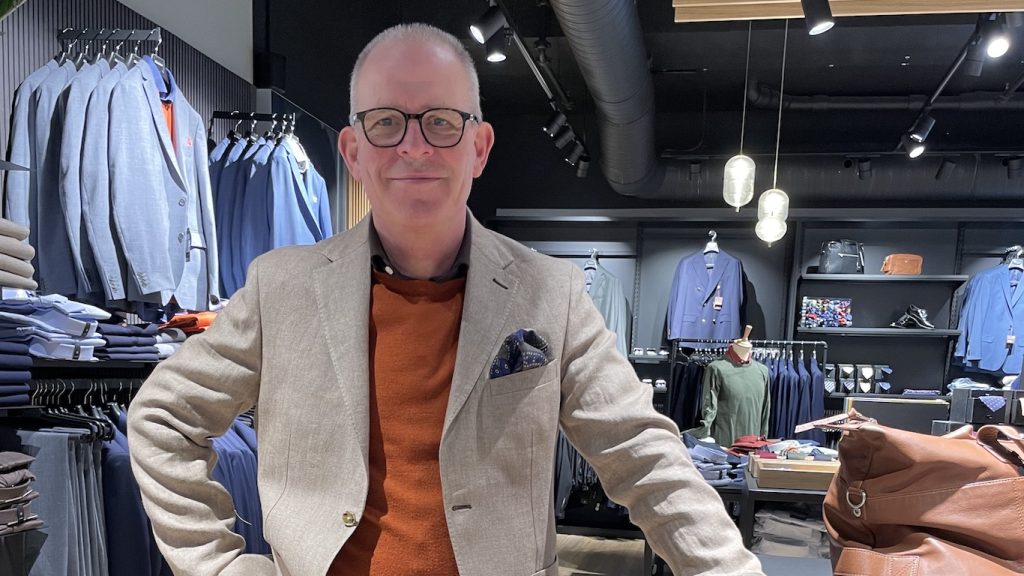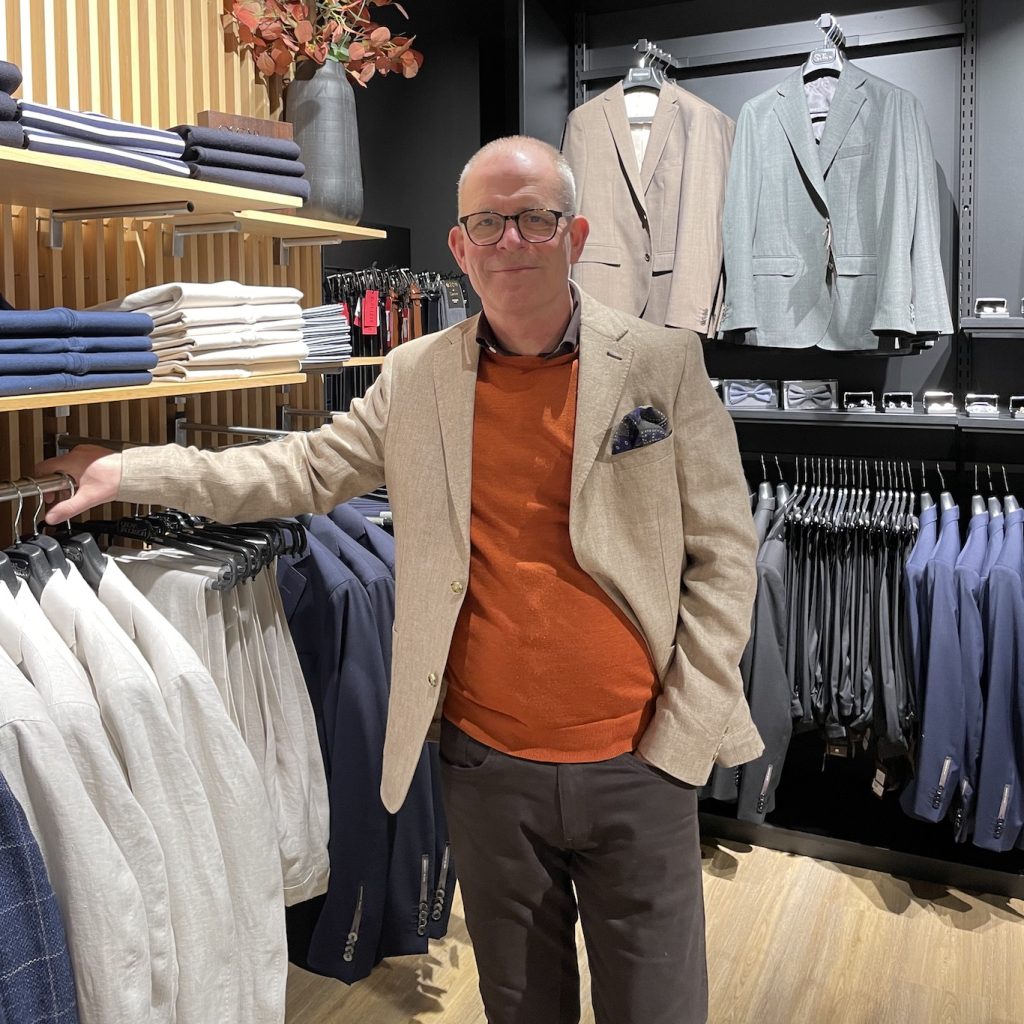Remarkable success with new customer experience
According to CEO Ole Espen Olsen at Gogstad Menswear, it’s all about being fully present on the shop floor. The Sandefjord menswear shop is now totally aware in the cityscape after moving into its newly renovated premises.

“Grand opening”
For 16 years, Ole Espen Olsen and his employees ran a good business with Gogstad Menswear in Borgegården until last autumn, when they unveiled their brand new premises in Dokkenkvartalet. The results have surpassed every expectation. We call Olsen for an early morning chat before opening hours.
Gogstad Menswear saw good growth in its former premises, but they needed more space, says Olsen.
When they heard about available premises in a new building, “300 metres down the street”, it got the ball rolling.
“In the board, we agreed to go for it. And it’s been really good, I mean I’ve never seen anything like it”, Olsen reminisces.
“How did you celebrate the new location?”
“We moved further downtown, closer to the plaza, with bigger crowds milling about. So, we had a fantastic opening, a fantastic Christmas, and a splendid new year. We’re very happy about what we did, he says.
Born beneath a clothes rack
The driven Olsen is quick to laugh. But he’s dressed to the nines with passion and dedication, something he likely also inherited.
His grandfather founded the menswear shop Ole Olsen in 1946, which his son later would take over. When Ole Espen Olsen himself was born in 1961, it was practically carved in stone that he would be the next in line. At an age as young as 15, Olsen could be spotted among the shop shelves.
When the year 2006 came around, Gogstad Menswear opened its doors with Olsen at the reins for the first time. And last year, the Gogstad adventure moved on at a new location and 280 square metres to fill.
“You haven’t done your job until that customer comes in to shop again.”
Ole Espen Olsen
Clear product arrangement
“I suppose it wouldn’t make sense to ask what’s new, because it’s still you, but what’s different at your new address?”
“The new premises are much easier to browse through. When you come in here, you can see everything.”
“So, when I step inside Gogstad Menswear, what do I see?”
“You’ll see jeans on the left, ready-made clothing at the end, as well as our various shop-in-shop options. There’s a Gant shop, a Tommy Hilfiger shop, a Matinique shop, and an Oscar
Jacobson shop. They’re at various locations within the shop, and you can see them quite clearly. I like having things be tidy around me, so we keep the shelves neat at all times.”
“How important is the placement of items, in your opinion?”
“Where you put items is incredibly important. The work we did in advance… it was quite a job, putting it all together! You can’t just toss a shirt here or a suit there. There has to be some thought behind it.”
“How does your inventory change in spring?”“The colour scheme will be completely different then, the shop gets a new outfit. Out go the down jackets, wool coats, knit caps, gloves, and scarves, and in come the spring jackets, linen shirts, linen blazers, and shorts. The shop is utterly transformed. Autumn has more earth tones, a lot of black and grey and brown, but for now, it’s light blue and bright colours. Next to the permanent fixtures that sell all year round, blue and grey suits, jeans, and chinos, we’re now in vibrant colours.”

“Now this is a lovely shop”
At Gogstad Menswear, it’s all about creating a complete experience for the customer. A tidy shop is just one part of that. It’s been a few months since the move, but customers are still coming in and praising the brand new venue:
“It warms my heart. People stand and mingle at noon on a Saturday, and I hear them say: ‘Now this is a lovely shop, this place is so nice now’. Ah, I feel like my work is finished, then. My day is made,” Olsen laughs, adding:
“It’s always great to get something back for the effort you put in. Everything from A to Z: Flooring, counters, the interior design, lighting and colour choices, the red mat outside, the new logo, outdoor lighting, the flowers… There’s an environment here.”
“How did you do the interior?”
“We used a Sandefjord company that is excellent at interior design. We’ve worked with them for many years. We had numerous meetings with the designer, and we concluded that the counter should be curved, among other things. And it turned out wonderful! The slats in the front, the built-in lighting, and everything. It cost a bit of money, but when you’re already making such a big deal with this move, you’ve got to get quality.
The new shop has also piqued the curiosity of new customers,” says Olsen, adding that he’s never satisfied until the customers come back for a second visit.
“But now they’re coming back for the third and fourth time. That means we must have done something right here, I think.”
“There are always holidaymakers coming to visit each summer, and since they can now come and see us at our new premises, I think they’re in for a good surprise.”
Ole Espen Olsen
When “just browsing” becomes “trying to get your attention”
Sandefjord is known as one of Norway’s most attractive municipalities to own a cottage. In the summer, that means that the population grows by tens of thousands in the Vestfold city.
“There are always holidaymakers coming to visit each summer, and since they can now come and see us at our new premises, I think they’re in for a good surprise. I’m looking forward to it.”
When Olsen meets customers, he’s fully present. He notes the customers’ needs and takes it
from there. As a rule, he’ll “throw something together”: Everything from casual outfits to finer attire.
“You’ve got the people who are walking around alone and who just want to take a peek, but they’ll ask for help after a while. Then you’ve also got those who want help right away. In my case, as I know so many people who live in this city, the “friend conversation” gets going right away. The dialogue with the customer, your chemistry, I think that’s very important. The customer should feel at home here. Of course, you get different kinds of customers, things may move slower with some people, but that’s what makes it important to keep the conversation going.”
Olsen takes a short break and thinks a little before continuing:
“But, now that I’ve been doing this for so long, it’s pretty much ingrained in me. It’s automatic. It’s about experience and routines. I practically know this place better than my own living room.”
“There are also a lot of people who just want to walk around and look. In that case, we make sure to pay close attention: Suddenly they may want our attention, and we’ve got to be there when that happens. Don’t let go of customers who come in to take a peek. Keep them in your peripheral vision.”
“This reminds me a little of how it’s not the food that makes a restaurant experience amazing, it’s the service …” “Yes, oh, I’m terrified of losing a customer because the service wasn’t good enough. Because it can go the other way too, you can nag a customer to death. You absolutely mustn’t do that, because a lot of people do like to have a look on their own. That said, the moment they want to look to you, you’ve got to be there.”
Remembering the customer from last year
“How do you convey this enthusiasm to your employees?”
“I say: ‘We’ve got to be ready now, and we’ve got to keep up. We can’t lose even one customer.’ That might be why we’ve done so well. Our service is good here, and our team is wonderful.”
“Is this, call it your service attitude, something you picked up over the course of your career, or is it from somewhere?”
“I learned something from my marketing professor. I remember it like it was yesterday. He said: ‘You haven’t done your job until that customer comes in to shop again.’”
He lets that quote hang in the air for a while, before continuing:
“That is, if you come to me and buy jeans, and I don’t see you again after that, then I haven’t done my job. And the service must be just as good whether you’re coming for the first time, buying a pair of socks for NOK 99, or if you’re buying a suit for NOK 5,500. Each customer is important.”
The service encounter drives everything. At this point, we’re getting close to the shop’s open hours for the day. We spend the last two minutes reflecting:
“It’s crystal-clear that you create a lot of good customer experiences, which leads to repeat purchases. Is that how it is?”
“Well, I hear people say: ‘Hey, I went to a party here, and we talked about you and the shop.’ So, we’ve reached people and made our mark, we’ve done something right. We’ve solidified our position, right, with the people of Sandefjord. It has been quite the adventure, I must say.
“But if some guy comes in now, a face you saw last summer, but you don’t know much more than that. Let’s say it was me…”
“I’d remember you,” Olsen says, “without a sliver of doubt”.
“You would?”
“Oh, yes. I’d remember you were here last year, and I’d say: ‘Oh hello, it’s you. You’re back again, eh?’”